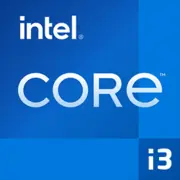Intel Core i3-1215U (IPU)

Intel Core i3-1215U: The Perfect Balance for Everyday Tasks
March 2025
Modern laptops require a balance between performance, energy efficiency, and price. The Intel Core i3-1215U processor, released in 2022, remains relevant in 2025 for budget and mid-range devices. Let's explore who this chip is suitable for, how it handles tasks, and what to pay attention to when purchasing.
1. Architecture and Process Technology: A Hybrid Approach and Subtle Nuances
Hybrid Architecture Alder Lake-U
The Core i3-1215U is built on the hybrid Alder Lake architecture, combining performance (P-cores) and efficiency (E-cores) cores:
- 6 cores (2P + 4E) and 8 threads (Hyper-Threading for P-cores).
- P-cores operate at a frequency of 1.2–4.4 GHz, handling "heavy" tasks.
- E-cores manage background processes and multitasking, with a base frequency of 0.9–3.3 GHz.
- 10 MB L3 cache—sufficient for office applications and light video editing.
10 nm Process Technology (Intel 7)
The chip is manufactured using the 10 nm Enhanced SuperFin standard, reducing power consumption and heat generation. This is a key factor for ultrabooks, where the thickness of the chassis is limited.
Integrated Graphics UHD 64EU
The integrated GPU Intel UHD Graphics (64 EU) supports:
- 4K@60Hz via HDMI 2.0b or DisplayPort 1.4.
- AV1 format for streaming video.
- Light gaming at low settings: for example, CS:GO achieving 40–50 FPS at 720p.
2. Power Consumption and TDP: A Fine Line Between Power and Battery Life
TDP of 15W allows the processor to be used in slim laptops without active cooling. However, in turbo mode, the consumption briefly reaches 29W, which requires a quality heatsink.
Example: Laptops like the ASUS Vivobook 15 or Lenovo IdeaPad 5 with the Core i3-1215U feature compact coolers that handle the load, but prolonged stress (e.g., video rendering) may result in throttling.
3. Performance: Real-World Usage Scenarios
Office Work and Multitasking
- Microsoft Office + 20 Chrome Tabs: the processor does not become overloaded, with E-cores managing background processes.
- Zoom Conference + Working in Excel: no delays, thanks to optimized thread management.
Multimedia
- 4K Video in VLC or YouTube: AV1 decoding reduces CPU load.
- Lightroom/Photoshop: photo retouching takes 2–3 seconds per operation.
Gaming
- The Sims 4 (1080p, low settings): 50–60 FPS.
- Genshin Impact (720p, minimum settings): 30–35 FPS.
In turbo mode, the frequency of the P-cores reaches 4.4 GHz, but after 2–3 minutes of gaming, throttling begins.
4. Usage Scenarios: Who is the i3-1215U Suitable For?
- Students: working with texts, online courses, Netflix.
- Office Workers: Excel, PowerPoint, email.
- On-the-Go Users: compact laptops with battery life of 8+ hours.
Not Suitable For: gamers, engineers (CAD), video editors.
5. Battery Life: How Does the Processor Save Charge?
- Intel Speed Shift: dynamic frequency switching based on workload.
- Dynamic Tuning 3.0: AI optimizes task distribution across cores.
- Windows "Power Saving" Mode: reduces the frequency of E-cores to 1 GHz.
Example: A laptop with a 50 Wh battery operates for 9–10 hours at a brightness of 150 nits (web surfing, documents).
6. Comparison with Competitors: Who Does the i3-1215U Outperform?
- AMD Ryzen 5 7520U (4 cores, 8 threads): better for multithreaded tasks (e.g., rendering) but more expensive ($600–$800).
- Apple M1 (8 cores): 30% more energy efficient but limited compatibility with Windows software.
- Intel Core i5-1235U (10 cores): 25% faster in demanding applications but has a TDP of 15–55W.
Conclusion: The i3-1215U excels in the budget segment ($500–$700).
7. Pros and Cons
Strengths:
- Low laptop prices (starting at $500).
- Support for Thunderbolt 4 and Wi-Fi 6.
- Cool operation during everyday tasks.
Weaknesses:
- Lacks power for AAA gaming.
- Turbo mode operates only briefly.
8. Recommendations for Laptop Selection
- Device Type: ultrabooks (Acer Swift 3) or budget models (HP 15s).
- RAM: at least 8GB (16GB is preferable for multitasking).
- Storage: 512GB NVMe SSD.
- Display: IPS panel with a resolution of 1920×1080.
Tip: Check the cooling system—reviews often report complaints about fan noise under load.
9. Final Conclusion
The Intel Core i3-1215U is an optimal choice for those who value portability and are not willing to pay for excessive power. It handles office tasks, streaming videos, and light gaming while maintaining battery life of up to 10 hours. However, for professional tasks or gaming, it is better to consider the Core i5 or Ryzen 5.
Key Benefits:
- Affordable price.
- Modern technologies (Thunderbolt 4, Wi-Fi 6).
- Ideal for work and study.
If your budget is constrained to $500–700 and your laptop requirements boil down to basic performance—the i3-1215U will be a reliable companion.
Basic
CPU Specifications
Memory Specifications
GPU Specifications
Share in social media
Or Link To Us
<a href="https://cputronic.com/cpu/intel-core-i3-1215u-ipu" target="_blank">Intel Core i3-1215U (IPU)</a>